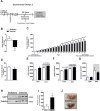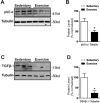Chronic exercise reduces hypothalamic transforming growth factor-β1 in middle-aged obese mice
- PMID: 28854149
- PMCID: PMC5611986
- DOI: 10.18632/aging.101281
Chronic exercise reduces hypothalamic transforming growth factor-β1 in middle-aged obese mice
Abstract
Obesity and aging are associated with hypothalamic inflammation, hyperphagia and abnormalities in the thermogenesis control. It has been demonstrated that the association between aging and obesity induces hypothalamic inflammation and metabolic disorders, at least in part, through the atypical hypothalamic transforming growth factor-β (TGF-β1). Physical exercise has been used to modulate several metabolic parameters. Thus, the aim of this study was to evaluate the impact of chronic exercise on TGF-β1 expression in the hypothalamus of Middle-Aged mice submitted to a one year of high-fat diet (HFD) treatment. We observed that long-term of HFD-feeding induced hypothalamic TGF-β1 accumulation, potentiated the hypothalamic inflammation, body weight gain and defective thermogenesis of Middle-Aged mice when compared to Middle-Aged animals fed on chow diet. As expected, chronic exercise induced negative energy balance, reduced food consumption and increasing the energy expenditure, which promotes body weight loss. Interestingly, exercise training reduced the TGF-β1 expression and IkB-α ser32 phosphorylation in the hypothalamus of Middle-Aged obese mice. Taken together our study demonstrated that chronic exercise suppressed the TGF-β1/IkB-α axis in the hypothalamus and improved the energy homeostasis in an animal model of obesity-associated to aging.
Keywords: TGFβ-1; aging; exercise; hypothalamus; obesity.
Conflict of interest statement
The authors declare no conflicts of interest in this study.
Figures




References
-
- Dato S, Rose G, Crocco P, Monti D, Garagnani P, Franceschi C, Passarino G. The genetics of human longevity: an intricacy of genes, environment, culture and microbiome. Mech Ageing Dev. 2017 https://doi.org/10.1016/j.mad.2017.03.011. Epub ahead of print. - DOI - PubMed
-
- Freisling H, Arnold M, Soerjomataram I, O'Doherty MG, Ordóñez-Mena JM, Bamia C, Kampman E, Leitzmann M, Romieu I, Kee F, Tsilidis K, Tjønneland A, Trichopoulou A, et al. Comparison of general obesity and measures of body fat distribution in older adults in relation to cancer risk: meta-analysis of individual participant data of seven prospective cohorts in Europe. Br J Cancer. 2017;116:1486–97. https://doi.org/10.1038/bjc.2017.106 - DOI - PMC - PubMed
-
- Nadrowski P, Chudek J, Skrzypek M, Puzianowska-Kuźnicka M, Mossakowska M, Więcek A, Zdrojewski T, Grodzicki T, Kozakiewicz K. Associations between cardiovascular disease risk factors and IL-6 and hsCRP levels in the elderly. Exp Gerontol. 2016;85:112–17. https://doi.org/10.1016/j.exger.2016.10.001 - DOI - PubMed
-
- Joo E, Fukushima T, Harada N, Reed JC, Matsuzawa SI, Inagaki N. Ubc13 haploinsufficiency protects against age-related insulin resistance and high-fat diet-induced obesity. Sci Rep. 2016;6:35983. https://doi.org/10.1038/srep35983 - DOI - PMC - PubMed
-
- Sousa-Ferreira L, de Almeida LP, Cavadas C. Role of hypothalamic neurogenesis in feeding regulation. Trends Endocrinol Metab. 2014;25:80–88. https://doi.org/10.1016/j.tem.2013.10.005 - DOI - PubMed
Publication types
MeSH terms
Substances
LinkOut - more resources
Full Text Sources
Other Literature Sources
Medical
Research Materials

